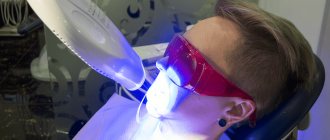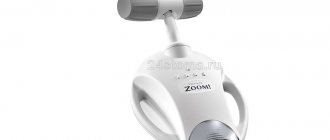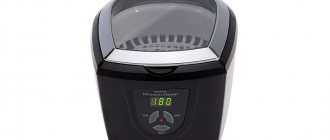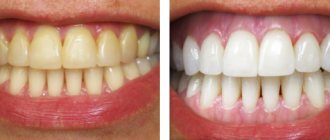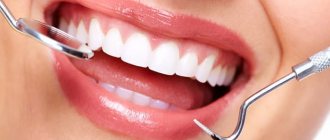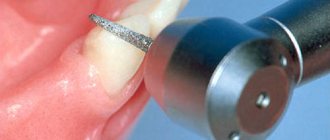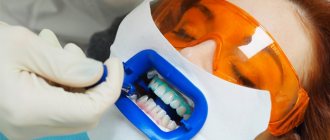Often, dental patients are offered a new method - lamp teeth whitening. Whitening is carried out with a LED lamp with cold light. Many people confuse this procedure with a procedure that uses an ordinary incandescent lamp, refusing to bleach using this method. Previously used lamps contributed to cracking of tooth enamel, spoiling it and causing a lot of unpleasant sensations. The impact of an LED lamp on tooth enamel occurs differently. What is this whitening method and how does it work?
System Features
To lighten teeth, a gel based on 35% hydrogen peroxide and a special lamp that generates light in the blue spectrum are used. Under the influence of high-frequency light waves, active oxygen is released from the gel, which penetrates into the deep layers of enamel and discolors accumulated pigments. The device’s lamp combines LED (Light Emitted Diode) technologies without heating and halogen light (Light Bridge) to enhance the effect. A complex system for filtering the supplied light includes special optical fibers and lenses, and protective coatings. 12 stages of protection allow you to obtain an output light flux with a wavelength of 520 nm. This is a cool range that is safe for enamel. The beam temperature is no more than 38 degrees. Unlike ZOOM whitening, there is no harmful ultraviolet radiation, which causes heating of dental tissues and increases tooth sensitivity. The procedure does not have a negative effect on the gums and teeth.
KonevaSvetlana Sergeevna
Dental hygienist, 5 years of experience
Specialist in safe whitening and color restoration of teeth enamel using the American Amazing White and Beyond Polus systems.
Make an appointment
“Beyond Pole” is an improved professional whitening system with expanded functionality. Unlike other devices, it has several operating modes. The light intensity is selected for each clinical case. Individual settings allow for gentle teeth whitening even with enamel damage or intense pigmentation. In the Beyond Polus system, the whitening gel is pre-mixed with a specially developed composition that neutralizes the harm of hydrogen peroxide directly during the procedure. The remineralizing components of the composition strengthen the enamel and reduce its sensitivity.
Despite the safety of Beyond Polus, violation of the technique can provoke demineralization of the enamel or “over-whitening” (an unnatural white tint). It is important to take seriously the issue of choosing a clinic and specialist. In our Center, the procedure is carried out by experienced hygienists who strictly follow the protocol. An individual regimen will be selected for you depending on the permeability of the enamel, the degree of staining, taking into account the problem that led to the need for teeth whitening.
Where in Moscow can you lighten your teeth with cold light?
Aesthetic dentistry services, namely hardware procedures, can now be found in almost every clinic in Moscow. Before choosing a place, make sure of the professionalism of the specialists and the quality of the material used. Read reviews or consult your dentist.
At the A-Medic clinic, you can not only do light teeth whitening, but also take advantage of other aesthetic dentistry services. At the first appointment, the doctor will help you choose the appropriate lightening technique that will suit you in terms of cost and quality.
Benefits of Beyond Polus whitening
The cold whitening technique has undergone numerous tests and is found to be effective and completely safe for health.
- Effective Whitening effect up to 10 tones depending on the initial situation. The result lasts up to 5 years if the recommendations are followed.
- Safe The cold light system in the lamp and the special gel composition ensure gentle whitening without tissue burns or tooth sensitivity.
- Fast The procedure lasts 30 minutes - 3 illumination sessions of 10 minutes each. Just half an hour during one visit for a snow-white smile.
- Comfortable Does not cause pain during the procedure. Individual settings are selected based on the degree of tooth sensitivity.
Beyond Polus is one of the safest whitening systems
Does not involve harmful ultraviolet or infrared radiation. Does not cause overheating of dental tissues, burns of mucous membranes and unnecessary tanning around the lips. The optimal range of light flux, individual settings, and the use of gel with protective components make the procedure as gentle as possible. Suitable for the most sensitive teeth.
Levin Dmitry Valerievich Chief physician and founder of the Doctor Levin center
Efficiency of photobleaching
You can usually whiten your teeth several shades. But the results of whitening, as well as its durability, regardless of the technique, are always individual. In many ways, the achieved effect depends on the natural shade of the teeth and the reasons for its change. For example, yellow teeth are more susceptible to lightening than gray teeth. A coffee or cigarette lover will be more likely to be satisfied with the results obtained, but someone with tetracycline teeth or fluorosis will probably waste their time and money. Therefore, if you are interested in the issue of effectiveness, then reviews from friends and colleagues about photo teeth whitening are unlikely to be useful to you. “I want teeth whiter than my girlfriend’s!” – You shouldn’t make such a request even to the best specialist. If you need a guaranteed result, it makes sense to think about installing lumineers, which quite effectively solve the problem of yellow teeth.
Indications
Cold whitening with a Beyond Polus lamp is performed in cases of tooth discoloration due to various factors
The main reasons why patients come to our Center:
- Taste preferences - color changes as a result of frequent consumption of coloring products, smoking
- Age-related changes - the enamel becomes thin, opaque, darkens as a result of the production of secondary dentin
- Fluorosis is the formation of colored spots or stripes on the enamel as a result of an excess of fluoride in the body
- Tetracycline teeth - stains due to uncontrolled antibiotic use in utero or childhood
Why does tooth enamel darken?
To get the most out of lamp whitening, you need to understand the causes of darkening of tooth enamel. In most cases, it is enough to eliminate the negative impact and clean the teeth so that the color of the teeth becomes natural again.
Dentin has a dark shade, which shines through a thin layer of enamel. A fair question arises: how does it happen that dentin darkens if the enamel is strong and can protect the tooth from many negative factors?
The reason is quite simple. It lies in the universal love for solid foods and sour drinks. Seeds, nuts, lemonades and other similar products contribute to the deformation of the upper layer of teeth. Through scratches and chips, pigments easily penetrate into the tooth tissue, staining the dentin.
The main factors influencing the color of teeth:
- The most popular reason is the consumption of foods that contain large amounts of coloring substances. These can be the following things: cranberries, blueberries, beets, strawberries, various candies and sodas, coffee, strong tea and much more. If this is the reason for the darkening of your teeth, then careful hygiene and periodic professional cleaning (once or twice a year) will help.
- Change • Change in enamel color is common in smokers. The main problem here is the tar that is in the cigarette. Together with smoke, they fall on the surface of the teeth and settle in the form of a dark plaque. Gradually, this sediment destroys tooth enamel, which can lead to caries and more serious diseases. In addition, smoking also has a negative impact on your gums. The best option in this case would be to quit smoking completely. If this is not possible for you, try to reduce your cigarette consumption to a minimum and pay more attention to oral hygiene.
- The tooth may darken due to injury, which led to damage to the neurovascular bundle. In this case, consultation with a specialist is necessary. Until the cause is eliminated, whitening will not help lighten the tooth.
- The shade may change due to the removal of the nerve; the darkening may not appear immediately, but also requires the intervention of a specialist.
- Filling a canal can lead to staining of the enamel; it all depends on the material used to fill the hole.
- Progressive caries is an advanced case of ordinary caries. The fact is that if such damage is not eliminated, small black spots will increase, destroying the enamel and then the dentin.
- Teeth may have congenital characteristics that are in no way related to caries or other damage. They can differ in structure, tone, shape, and so on. In some cases, it is possible to change their color only with the help of special overlays - veneers.
- Excess fluoride in the water you drink can lead to fluorosis. At the beginning of the disease, dark spots or chalky streaks appear on the teeth. The progression of the disease leads to the destruction of enamel and then dentin. Whitening such teeth is not possible until you get rid of fluorosis.
- Taking tetracycline antibiotics during pregnancy can negatively affect the condition of the baby's teeth.
Stages of the procedure
The procedure itself is carried out in one visit for half an hour. If plaque, stones on the teeth, or inflammatory processes in the oral cavity are detected, preparatory measures are carried out first
Preparation
Whitening is preceded by a preparatory stage, which is aimed at eliminating obstacles to the procedure and ensuring the proper result. Mandatory includes an examination of the oral cavity and diagnostics. If necessary, the following is prescribed:
- professional teeth cleaning from soft and hard plaque
- treatment of dental diseases
- remineralization of enamel to strengthen it
3-7 days before whitening, it is recommended to brush your teeth only with white toothpaste, and also to exclude from your diet foods that can stain the enamel (coffee, wine, carbonated drinks, ketchup, carrots, beets, chocolate).
How is whitening performed?
- Preparation The patient's eyes are protected with special glasses. A retractor is fixed in the mouth. The lips are lubricated with cream, and a liquid rubber dam is applied to the gums to protect the mucous membrane from the chemical components of the drug.
- Whitening Teeth are coated with 35% hydrogen peroxide gel with protective components. The composition is illuminated with a Beyond Polus lamp for 10 minutes. The stage is repeated 3 times; before each application of the gel, the previous layer is removed.
- Strengthening enamel A remineralizing agent containing calcium, phosphorus and other components is applied to the teeth. Prevents enamel fragility, helps strengthen it, protects teeth from sensitivity.
Contraindications
Beyond Polus technology is safe for enamel, but some patients should refrain from whitening procedures, not only with this system
Among the absolute contraindications:
- age up to 16 years
- allergy to the components of the drug
- period of pregnancy or lactation in women
- serious health problems (malignant neoplasms, pathologies of the circulatory, cardiovascular, immune systems)
Relative restrictions that need to be corrected before the whitening procedure include:
- open caries, pulpitis
- periodontal tissue diseases
- enamel cracks
- outdated fillings with poor fit
Will not cope with hypoplasia and fluorosis
The technology will not be effective against non-carious lesions and stains that affect the aesthetics of the smile: hypoplasia, fluorosis, wedge-shaped defect. Especially if the pathologies are severe.
Are any of the professional whitening methods effective for the listed defects? Researchers claim that some types of hypoplasia, mild fluorosis and even tetracycline teeth are best treated with ZOOM technology. But most often, such patients are still offered to install veneers, lumineers and crowns (if the teeth are severely damaged), which, in addition to adding aesthetics to the smile, help protect the enamel from external influences, destruction and caries.
The technology will not be effective against fluorosis
How to prolong the whitening effect
On average, after bleaching Beyond Polus, enamel remains white for one year. However, this indicator depends on subsequent oral care and compliance with specialist recommendations:
- during the first 3-4 hours after the session you cannot eat;
- It is advisable not to smoke for a day;
- women should refrain from applying bright lipstick to their lips for three days;
- for two weeks, exclude foods that can stain the enamel - chocolate, coffee, wine, beets, carrots, carbonated drinks;
- Brush your teeth regularly - at least twice a day with a special toothpaste prescribed by your doctor.
The e-Bright system specially developed by Beyond for home use allows you to significantly extend the whitening effect. It complements the desk procedure and is aimed at consolidating the results obtained. The set includes a gel and a dental guard with built-in LED lights. The home course should begin 2-3 weeks after the clinical course. The idea is to apply the drug to the teeth and wear the mouth guard for 20 minutes. Performed once a day for 8-10 days.
Comments
There is a filling on the front tooth, will it be whitened using the methods you listed?
Valya (06/08/2020 at 01:15) Reply to comment
- Dear Valya, fillings and artificial crowns cannot be whitened by any of the methods existing today. If you want to whiten the enamel, then the filling will need to be changed so that it matches the color of the new shade of the teeth.
Editorial staff of the portal UltraSmile.ru (06/13/2020 at 09:15) Reply to comment
Is it possible to do cold bleaching immediately after air flow?
Laura (06/27/2020 at 01:24 pm) Reply to comment
- No, you need to wait at least 7–10 days: during this period you need to use special pastes and remineralizing compounds.
Editorial staff of the portal UltraSmile.ru (07/03/2020 at 09:47) Reply to comment
Will they give me an anesthetic injection before bleaching, otherwise I’m afraid...
Zverev S. (07/13/2020 at 15:47) Reply to comment
- Injection anesthesia is not used for such a procedure, but the gums and soft tissues will be treated with a special protective gel that reduces sensitivity and the likelihood of irritation of the mucous membrane.
Editorial staff of the portal UltraSmile.ru (07/17/2020 at 09:08) Reply to comment
Write your comment Cancel reply
Alternative whitening systems
Our Center uses another safe teeth lightening technology - Amazing White, also from an American manufacturer. Like Beyond Polus, cold whitening technology is used. But Amazing White uses a gel with a lower concentration of the active substance - 16%. The lightening intensity is correspondingly lower - by 3-6 tones. Since our Center specializes in implantation and surgery, this system is ideal for teeth whitening even in the postoperative period without irritating the mucous membranes. Suitable when you want to get an immediate aesthetic effect soon after surgery.
We do not use the advertised Zoom technology, despite the same effectiveness as Beyond Polus. The system is not safe for tooth enamel. The technology is based on a gel with a peroxide concentration of 25% and a UV lamp with thermal radiation. Overheating of the enamel-dentin layer is possible, which is accompanied by prolonged increased sensitivity of the teeth. In addition, preparation for the procedure requires special scrupulousness in order to protect the mucous membranes from burns and prevent unnecessary tanning around the lips.
The essence of the technique
Cold light whitening is based on the principle of using a dental gel with a special composition. The active components of the drug lighten the surface of the enamel under the targeted influence of light.
The main component of the drug is hydrogen peroxide.
The light beam passes through many filters. IR and UV spectral fluxes are neutralized. As a result, the teeth are exposed to cold light.
The dental elements do not heat up, therefore, the patient does not experience discomfort.
